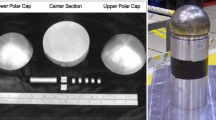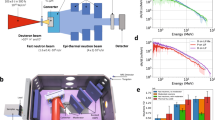Abstract
DETECTION of selenium by neutron irradiation and gamma scintillation spectrometry has been attempted. It is known that, when natural selenium is irradiated with neutrons, selenium-75 (121 days), selenium-77 m (17.5 sec.) and selenium-81 (18.2 min.) are formed with comparatively large cross-sections. When any one of them is used to detect selenium, irradiation must be continued for a period comparable to the half-life. Therefore, it was thought that the use of selenium-77 m offered a method for the rapid detection of selenium ; this method has not been described in the literature examined.
This is a preview of subscription content, access via your institution
Access options
Subscribe to this journal
Receive 51 print issues and online access
$199.00 per year
only $3.90 per issue
Buy this article
- Purchase on Springer Link
- Instant access to full article PDF
Prices may be subject to local taxes which are calculated during checkout
Similar content being viewed by others
Author information
Authors and Affiliations
Rights and permissions
About this article
Cite this article
OKADA, M. Non-destructive Analysis of Selenium by Neutron Activation followed by Gamma-Ray Spectrometry. Nature 187, 594–595 (1960). https://doi.org/10.1038/187594a0
Issue Date:
DOI: https://doi.org/10.1038/187594a0
This article is cited by
-
Neutron activation and radiochemical separation of selenium from environmental and food samples from and around Bombay using ethyl-α-isonitrosoacetoacetate
Journal of Radioanalytical and Nuclear Chemistry Articles (1987)
-
The radioanalytical bibliography of Japan (1936–1978)
Journal of Radioanalytical Chemistry (1982)
-
Die Bestimmung von Selenspuren
Fresenius' Zeitschrift für analytische Chemie (1964)
Comments
By submitting a comment you agree to abide by our Terms and Community Guidelines. If you find something abusive or that does not comply with our terms or guidelines please flag it as inappropriate.



